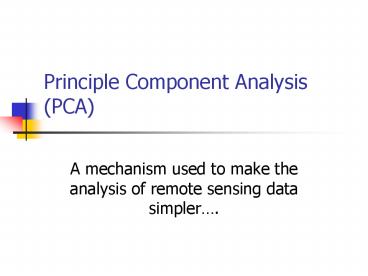Principle Component Analysis (PCA) PowerPoint PPT Presentation
1 / 26
Title: Principle Component Analysis (PCA)
1
Principle Component Analysis (PCA)
- A mechanism used to make the analysis of remote
sensing data simpler.
2
PCA
- reduces the dimensionality of the data
- keeping the (what we hope) is the most
significant parts of the data - simultaneously filters out noise
- It is a way of identifying patterns in data, and
expressing the data in such a way as to highlight
their similarities and differences
3
PCA contd.
- hyperspace graphing is not available to
visualize data - the 3 first principle components make a powerful
tool for identifying patterns in the data - This is can be seen as a tool for image
compression with no loss of information
4
(No Transcript)
5
History
- Early image processing systems were limited in
their processing capacity it was important to
reduce the number of calculations required to
process an image. - Currently, useful as tool to explore the
variability of an image - Also used in facial recognition software
6
How it works
- The data, though clumped around several central
points in that hyperspace, will generally tend
towards one direction. - If one were to draw a solid line that best
describes that direction, then that line is the
first principle component (PC).
7
Eigenvectors and Eigenvalues
- Each eigenvector represents a principle
component. - The first Principle Component is defined as the
eigenvector with the highest corresponding
eigenvalue. - The individual eigenvalues indicate the variance
they capture - the higher the value, the more
variance they have captured.
8
- Any variation that is not captured by that first
PC is captured by subsequent orthogonal
eigenvectors. - When the data is plotted in this manner they are
said to be plotted in Principle Component-space
(PC-space)
9
(No Transcript)
10
Data means WHAT?
- The first PC represents the greatest variability
in the data - so?
- How does the interpreter convert variability
into information?
11
Image Registration and Rectification
- Removing spatial errors in an image
- Systematic errors
- (skew)
- Curvature of the earth
- General instrument correction e.g. scan line
overlap
12
Projection and Random errors
- In order to get RS data into a format compatible
with the GIS, a projection needs to be specified - (the alternative is to do an image based GIS
that ignores real world coordinates)
13
Ground Control Points (GCPs)
- Use GCPs that are well distributed across the
image - Features visible on the image that correspond to
known locations on the ground (or on a map) - GCP1- XY (UTM?)
- GCP1-row/column
14
(No Transcript)
15
Affine Coordinate Transformation
- X a0a1Xa2Y
- Y b0b1Xb2Y
- Where x and y are the row/ column locations
- And X,Y are the ground coordinates
- an and bn are transformation parameters
16
(No Transcript)
17
Page 2 (of 3) of the affine coordinate
transformation example in Jensen 1986
18
So how do we get new values into the projected
cells?
- Nearest neighbor
- The cell value from the original image closest to
the center of the new (rectified or projected)
cell is assigned to the new cell. - Simplest method
- Only rational method for classified images or
other grid data with interval data
19
Bilinear Interpolation
- Weighted average of the four nearest pixels (2
left-right and 2 up-down) - weighted average of a 2X2 kernel
20
Cubic Convolution or Cubic spline
- Cubic spline of 16 closest neighbors
- a weighted average of from a 4X4 kernel
21
How well do they work?
- Every manipulation of a grid changes the data in
every grid cell - The accuracy of the original data ?
- The accuracy of the new cells ?
- Loss of information ?
- The only real test of accuracy is how accurately
INFORMATION is supplied by the image.
22
Image Filtering
- Noise removal
- Smoothing
- Edge enhancement
- Most image enhancement operations work the same
way - A moving window
23
(No Transcript)
24
The kernel or window
- The factors in the moving window are specified
based on the desired result - The 3X3 array moves across the image and converts
the value of the center pixel based on the
operations specified by the surrounding pixels
25
A high pass filter or kernel
26
Directional Edge Enhancementexamples

